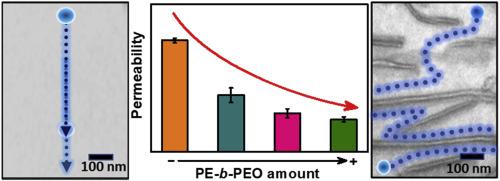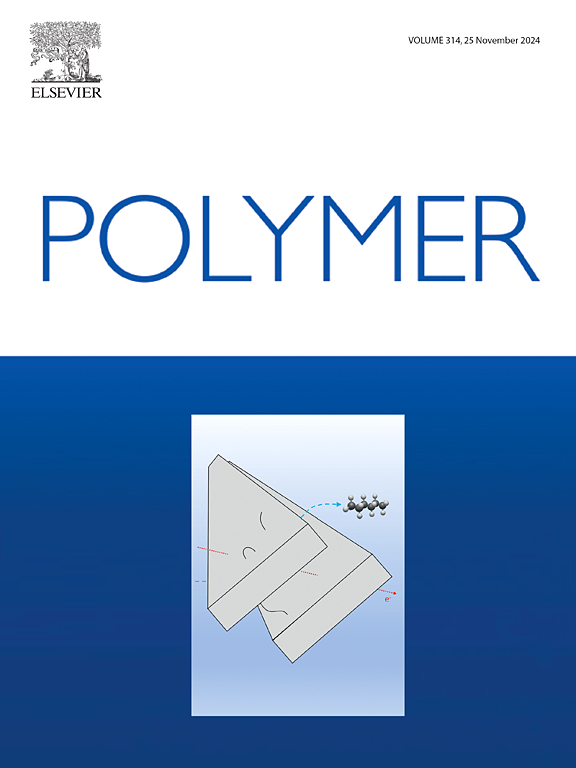环氧树脂和二甲丙烯酸酯基质中带状核晶胶束的制备及其作为屏障膜的潜在应用
IF 4.1
2区 化学
Q2 POLYMER SCIENCE
引用次数: 0
摘要
近年来,高纵横比结晶胶束的原位制备在聚合物基体中取得了重大进展。然而,对于这些结构如何影响渗透分子在基体中的扩散,我们所知甚少。这是这些材料在容器、涂料或包装等应用中作为屏障膜的潜在用途的关键因素。在这项工作中,我们在热固性基质中制备了带状核晶胶束,并分析了它们对势垒性质的影响。采用结晶驱动自组装(CDSA)法制备了聚乙烯块-环氧乙烷(PE-b-PEO)在双酚A二缩水甘油酯(DGEBA)和聚乙二醇二甲基丙烯酸酯(PEGDMA)两种不同基质上的材料。DGEBA是一种刚性基体,可以通过电晕形成的PEO块进行塑化,而PEGDMA是一种柔性基体,其玻璃化转变温度与PEO相匹配。这种方法使我们能够通过区分刚性晶核和柔性电晕的影响来分析胶束结构的行为。通过水扩散和渗透率测量,我们证明了晶体岩心显著改善了屏障性能,这些岩心作为不渗透的障碍物,为渗透分子通过聚合物基质的扩散产生了曲折的路径。虽然电晕形成块可以作为基体的增塑剂,但由晶芯引入的扭曲是速率控制因素,因此决定了屏障性能的改善。本文章由计算机程序翻译,如有差异,请以英文原文为准。

Preparation of ribbon-like core-crystalline micelles in epoxy and dimethacrylate matrices for potential applications as barrier membranes
Significant progress has been recently achieved in the in-situ preparation of high-aspect-ratio crystalline micelles in polymer matrices. However, very little is known about how these structures affect the diffusion of permeant molecules through the matrix. This is a key factor for the potential use of these materials as barrier membranes in applications such as containers, coatings or packaging. In this work, we prepare ribbon-like core-crystalline micelles in thermosetting matrices and analyze their impact on the barrier properties. The materials were prepared by crystallization-driven self-assembly (CDSA) of poly(ethylene-block-ethylene oxide) (PE-b-PEO) in two different matrices: diglycidyl ether of bisphenol A (DGEBA) and poly(ethylene glycol) dimethacrylate (PEGDMA). DGEBA is a rigid matrix that can be plasticized by the corona-forming PEO block, whereas PEGDMA is a flexible matrix with a glass transition temperature that matches that of PEO. This approach allowed us to analyze the behavior of the micellar structure by distinguishing between the effects of the rigid crystalline core and the flexible corona. From water diffusion and permeability measurements we demonstrated that barrier properties are markedly improved by the crystalline cores, which act as impermeable obstacles generating a tortuous path for the diffusion of permeant molecules through the polymer matrix. Although the corona-forming block can act as a plasticizer of the matrix, the tortuosity introduced by the crystalline core is the rate-controlling factor and, as such, determines the improvement in barrier properties.
求助全文
通过发布文献求助,成功后即可免费获取论文全文。
去求助
来源期刊

Polymer
化学-高分子科学
CiteScore
7.90
自引率
8.70%
发文量
959
审稿时长
32 days
期刊介绍:
Polymer is an interdisciplinary journal dedicated to publishing innovative and significant advances in Polymer Physics, Chemistry and Technology. We welcome submissions on polymer hybrids, nanocomposites, characterisation and self-assembly. Polymer also publishes work on the technological application of polymers in energy and optoelectronics.
The main scope is covered but not limited to the following core areas:
Polymer Materials
Nanocomposites and hybrid nanomaterials
Polymer blends, films, fibres, networks and porous materials
Physical Characterization
Characterisation, modelling and simulation* of molecular and materials properties in bulk, solution, and thin films
Polymer Engineering
Advanced multiscale processing methods
Polymer Synthesis, Modification and Self-assembly
Including designer polymer architectures, mechanisms and kinetics, and supramolecular polymerization
Technological Applications
Polymers for energy generation and storage
Polymer membranes for separation technology
Polymers for opto- and microelectronics.
 求助内容:
求助内容: 应助结果提醒方式:
应助结果提醒方式:


